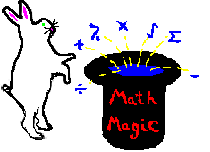

A. An
imaginary number is represented by i which is ![]() .
Usually we write imaginary numbers in the form: a + bi.
.
Usually we write imaginary numbers in the form: a + bi.
B. There are many ways of working with imaginary numbers. Below are some things you should know:
1. Powers of i:
i0 = 1; i1 = i; i2 = -1; i3 = -i.
Note: These are the only values for in. After this, the values repeat themselves. For example, i10 = -1. In general, in = i(n MOD 4)
Ex [1] i244 = _______
a. Since 244 MOD 4 = 0, i244 is the same as i0 = 1.
b. The answer is 1.
2. Conjugate:
a. The conjugate of an imaginary number, a + bi, is defined as being a - bi.
Ex [1] The conjugate of 4+5i is a+bi. b = ____.
a. The conjugate of 4+5i is 4-5i. So the answer is -5.
3. Modulus:
a. If you were to graph a+bi on a graph, the coordinates would be (a,b). Modulus is the distance from the origin (0,0) to the point (a,b).
b. Therefore, the formula for the modulus is:
![]()
Ex [1] The modulus of 5 + 12i is _______.
a. You
should know the Pythagorean Triple (5,12,13). The answer is 13. If
you don't you can see ![]() .
.
c. Therefore, knowing Pythagorean Triples will be very advantageous.
4. Multiplying 2 imaginary numbers together:
a. This method is going to use the same idea as the FOIL Method.
b. Multiplying 2 imaginary numbers gives an answer in the form of a+bi, since i2 = -1.
Ex [1] (3-2i)(5+4i) = a + bi. b = _____.
a. Since the question is asking for the 'b' value and not the 'a' value we are only concerned with the "OI" in the FOIL method.
b. (-2i)(5) + (3)(4i) = 2i. The answer is 2.
c. If the question had asked for the 'a' value, then we would only be concerned with the "F" and "L" in the FOIL method. So we would want (3)(5) + (-2i)(4i) = 15 - 8i2 = 15 + 8 = 23. So a is 23.
5. Powers of a+bi:
a. For any integral value of 'n', (x+yi)n, can be written in the form a+bi. Most of the time, on number sense tests, the power will be 2.
b. This method will use the fact that (x+y)2 = x2 + 2xy + y2. Remember that i2 = -1.
Ex [1] (3 - 4i)2 = a + bi. The b = _____
a. If we are looking for the b, then the answer is 2(x)(y). So in this case, the answer is 2(3)(-4) = -24.
b. If we are looking for the a, then the answer is x2 - y2. So in this case, the answer would be 32 - 42 = -7.
6. Dividing by a+bi:
a. The rules of imaginary numbers are similar to the rules of square roots since technically an imaginary number is a square root. One of these rules is you cannot have an i in the denominator. So when you are dividing by 2 imaginary numbers, you must multiply the numerator and the denominator by the conjugate of the denominator.
Ex
[1] ![]() =
a+bi. a = ____.
=
a+bi. a = ____.
a. To solve this problem we have to multiply the numerator and the denominator by the conjugate or by 2-3i.
b. Anytime you multiply a+bi by its conjugate, you get a2 + b2. So the denominator becomes 22 + 32 or 13.
c. Now, to find the numerator, we have to multiply (3-4i)(2-3i). Since the question just wants the 'a' value we are only concerned with: 3(2)+12i2 = 6 - 12 = -6. If the question wanted the 'b' value we would need to know (-4)(2) + 3(-3) or -17.
d. The answer is -6/13.